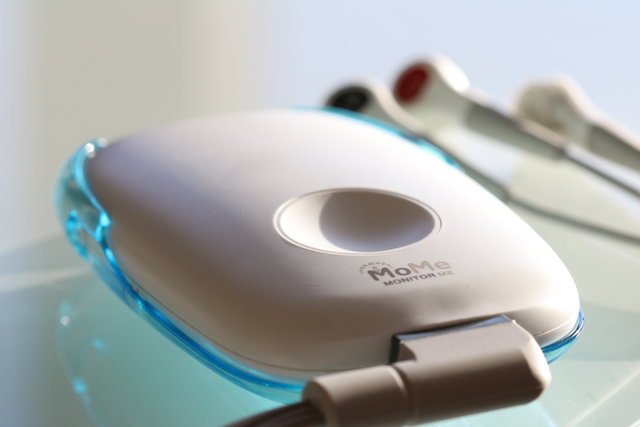InfoBionic
Putting Cardiologists Back in Control
InfoBionic empowers cardiologists with anytime access to patient mobile cardiac telemetry and provides full ownership of data and reimbursement.
By Stephanie Kreml,
MD
Diagnosing cardiac arrhythmias is difficult, and the journey usually starts with a Holter monitor. However, if the Holter doesn’t capture a patient’s irregular rhythm in the initial 24 to 48 hours, the cardiologist may need to switch the patient to an event monitor. And this requires another interaction with an independent diagnostic testing facility (IDTF).
For the cardiologist and the patient, the whole process of outsourcing to an IDTF is often time consuming and frustrating. On top of that, the IDTF collects most of the revenue for the monitoring procedure.
InfoBionic brings the entire process in-house for cardiologists, giving them access to 100 percent of a patient’s remote ECG data and the ability to bill for the technical component of the diagnostic procedure.
“Our MoMe Kardia 3-in-1 ambulatory ECG monitoring system empowers physicians with never-before-accessible control over the data they need to diagnose and manage patients that are suspected of having or are experiencing cardiac arrhythmias,” explains InfoBionic CEO Stuart Long. “Ours is the first universal cardiac monitoring platform providing true full disclosure with immediate access to all ECG data on any device. The platform enables the “seamless transition between Event, Holter, and MCT [mobile cardiac telemetry] with no time or effort on the part of patients, techs, or MDs.”
Diagnosing cardiac arrhythmias
We’re built around the cornerstone that the customer knows best.
With the MoMe Kardia platform the cardiologist doesn’t have to review hours and hours of ECG recordings. The platform’s dashboard highlights suspected cardiac events for the cardiologist to review. InfoBionic provides clinical decision support through “cloud-based analysis of patient data, validated by [quality assurance] professionals” and “on-demand access to automated reports,” Long says.
Even in the event monitor mode, the platform continuously records ECG data. If a patient forgets to trigger the event recorder, the cardiologist can still review the recordings because the platform saves all data on a secure cloud-based server. Long elaborates, “when the patient says on last Tuesday they felt a stabbing pain or radiation of pain down their arm, the physician can simply jump to last Tuesday to see the data while they are still with the patient.”
In fact, the platform provides full disclosure, so the cardiologist can review a patient’s ECG recordings at any time, even contemporaneously with no delay. And unlike traditional event monitors, the MoMe Kardia system allows cardiologists to see the full timeline surrounding the event so they can identify triggers for the event onset and offset.
Additionally, if the cardiologist has postoperative patients or patients with chronic cardiac conditions requiring mobile telemetry, the device can be easily set up in this mode as well. When a cardiologist adopts InfoBionic’s platform, they have “unlimited usage of the 3-in-1 MoMe Kardia device and software” with the “ability to change testing modes remotely,” Long explains.
This can eliminate some of the frustrations patients may have with the IDTF model, since IDTFs often send the devices to the patient, expecting them to figure out how to attach the ECG leads themselves. Long elaborates, “The confidence in the device and the software is established prior to the patient leaving the cardiologist which enhances patient compliance.”
Reclaiming ownership of this diagnostic service line has multiple benefits, from improved quality to increased practice revenue. “What we’ve seen over the past couple of years is substantial adoption by key opinion learners who, after experiencing the value of ownership (owning your own data and being able to bill for the technical component), have become resolute in abandoning the outdated models of the traditional IDTF,” recounts Long. “The current IDTF model is an anachronism and will disappear as machine learning and AI [artificial intelligence] are increasingly applied to all areas of physiologic monitoring.”












InfoBionic brings the entire process in-house for cardiologists
Full Disclosure and Security
Recapturing Reimbursement and Improving Compliance


While the MoMe Kardia device continuously sends raw ECG data to its cloud-based servers, “InfoBionic is dedicated to maintaining the security and privacy of protected health information (PHI),” Long says.
To address rising concerns about cybersecurity, the MoMe Kardia platform complies with all industry standards, and InfoBionic has implemented the best practices required by HIPAA and HITECH regulations.
All data are encrypted, both at rest in the database and in transit via SSL or TLS. A full audit trail of every activity is recorded with login credentials and date/time stamps. InfoBionic employs an Intrusion Detection System (IDS) with active threat monitoring and management along with central identity management, including complex password requirements and a 90-day expiration with history.
Only limited personally identifiable information (PII) is collected by the system, and InfoBionic’s cloud partner provides HITRUST certification and HIPAA compliance through its business associate agreement.
After receiving their FDA 510(k) clearance in 2015, InfoBionic focused on bringing the remote diagnostic service line back to the cardiology practice. With InfoBionic, the cardiologist owns the MoMe Kardia equipment and can bill for its use, without having to deal with an IDTF.
“The cardiologist owns the entire service line so they prescribe the test, give the patient their MoMe Kardia, hook them up on the device and show the patient their data running on a computer or mobile device before they leave the office,” Long explains.
Stuart Long, CEO of InfoBionic
“Our current customers are cardiology practices across the U.S.,” Long says. “We’re built around the cornerstone that the customer knows best. Yet building what they need requires a lot of understanding and translation from clinical to technical and back.”
Long believes InfoBionic has the right culture to further the company’s progress in the realm of remote patient monitoring. “The single most important thing we do is hire and retain talented people.” He elaborates, “I focus a lot of my attention at InfoBionic in creating and evolving an environment for employees to feel like they are part of something, making real and positive change in healthcare versus just going to their job every day.”
Long then aligns his team to work on “a great product that meets the needs of the customer and ultimately does good things for their patients in new and innovative ways.”
This pursuit of platform improvement with attention on the requirements of cardiologists is continuing to bring new features and increased quality to clinicians. “Last year we released a 6-lead view with our 2 channel 3 lead-wire set [and] a focus on artifact reduction/removal in alternate lead views,” Long explains.
And the advances keep coming. Long continues, “the next 12 months will reveal novel introductions of a tiered suite of wireless lead sets, and the MoMe platform will expand to enhance the clinical requests of our customers.” These will address “clinical parameter collection, form factor, power and communication along with new [intellectual property] on the AI side.”
